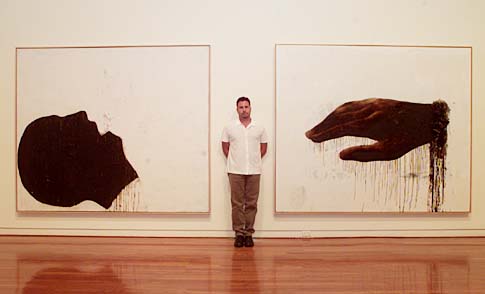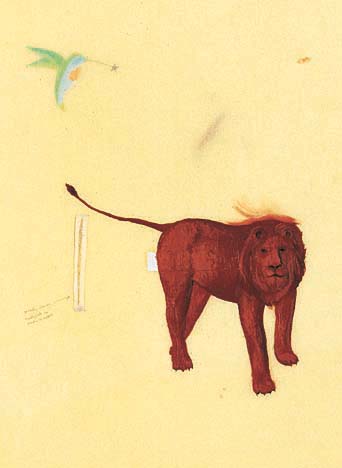


Local Color![]()
Sunday, August 26, 2001

ENRIQUE MARTINEZ CELAYA, considered a brilliant artist in serious art circles, first made a name for himself with his black paintings when he was still a graduate student at the University of California, Santa Barbara. The paintings from 1992 to 1993 are true to the label -- large fields of flat black, nearly devoid of colors or images and difficult for the camera to capture their subtlety. Martinez Celaya
scraps art education to
reinvent paintingIn a survey of the young artist's career (he's only 36,) the black paintings from his early days are the first artwork to greet visitors to The Contemporary Museum. They are intriguing and certainly testify to reasons that made Martinez Celaya a celebrated artist. But what delivers an immediate punch to the stomach is a pale painting downstairs at the museum.
"Quiet Night (Recollection) I" has a trio of hummingbirds pecking away at a human face. The face is not much more than a blob of white. It has no eyes but the nose and mouth are rendered in excruciatingly bloodied detail. The birds hover, as if the blood, the color of deep-red pomegranates, were tasty nectar.
Where: University of Hawaii Art Department Auditorium Slide lecture by
Enrique Martinez Celaya
When: 7:30 p.m. Sept. 4
Cost: Free
Call: 956-8474
Paintings, Drawings, Sculpture, Installations and Photographs Enrique Martinez Celaya,
1992-2000Where: The Contemporary Museum, 2411 Makiki Heights Drive
When: 10 a.m. to 4 p.m. Tuesday through Saturday, noon to 4 p.m. Sunday, through Oct. 21.
Cost: $5, $3 for seniors and students, free to members and children 12 and under.
Call: 526-1322.
"To me this painting is charged with sadness and regret and a number of things that are preoccupations with sorrow," Martinez Celaya said.
He prefers not to psychoanalyze his own paintings. Although, he said, all artists' works are autobiographical in some form. The images and the emotions may stem from his own experience and explorations, but he wants his work to have larger philosophical meanings that speak of the human condition.
His work is influenced as much by his unusual life as his fondness for poetry, literature and philosophy, he said. His friends tend to be writers and philosophers, not artists, and his poetry has been published in books.

Martinez Celaya was born in Cuba and liked drawing and painting while growing up. His family lost its comfortable existence after Fidel Castro came to power. His father, who once oversaw operations at a sugar plantation, moved the family to Spain where he worked in construction and other manual labor jobs.When he was 9, Martinez Celaya became an apprentice to an artist, partly because of his talent for art and partly because it paid a meager stipend that supplemented the family's income.
He also had a natural ability in science and mathematics. The family later moved to Puerto Rico, where he excelled in his high school studies and graduated as class valedictorian. He came to the United States to attend Cornell University.
"I chose to study physics in college because it was much more sensible than art (as a career.) I always did art on the side, and I thought I could keep it as a hobby," he said.
He did well in school and received a scholarship for post graduate studies at the University of California, Berkeley. He earned a master's degree in physics while managing to add art studies to his curriculum.
"Then I decided I have been doing what people have been telling me to do," he said. He dropped out of his doctoral studies, moved to Oakland and indulged in art full time, selling paintings at park fairs.
"It was a very poor existence. My parents were very disappointed. They thought I'd be a doctor or scientist, and here I am -- a poor artist," he said.
He was so poor that he could not afford to see a doctor when a stretcher bar fell on his head and caused a big gash. The wound became infected and he developed a big bald spot on his head. He finally sold a painting in time for him to seek medical treatment.
Martinez Celaya decided to return to school, but this time he went for a graduate art degree. From the beginning his work drew critical praises and was included in important shows.
After his graduation, he decided on another detour. "I decided to reinvent painting," he said. "For years, I was told what was working in my art. This was nice and that was nice. I decided I have to scrap everything and start from scratch."

He threw out the figurative painting style that earned him notice and concentrated on the black paintings. He disregarded composition and color and other elements of art making."I chose black because it's a form of emptiness that was very reassuring to me. I feel physically and spiritually close to black," he said. Once in awhile he deviated from black and painted with a very dark and somber red.
"My idea was to move artwork away from the appearance and shift it into something that is not decorative," he said. Artists mistakenly believe their task is to create beauty, which ends up being all about looks. But appearance, or the preoccupation with appearance, is the trap that keeps art as nothing more than mere pretty pictures.
He wishes for his work to have meaning beyond aesthetics, although he isn't able to sort out meanings until long after pieces are completed. His artwork, which includes sculpture and photography, is about "applying precision to things that are imprecise."
"My artwork has nothing to do with prettiness. If it's pretty, it's purely accidental. Let me tell you, no one is more surprised than me that my paintings have been successful."
Gardening Calendar
Suzanne Tswei's art column runs Sundays in Today.
You can write her at the Star-Bulletin,
500 Ala Moana, Suite 7-210, Honolulu, HI, 96813
or email stswei@starbulletin.com